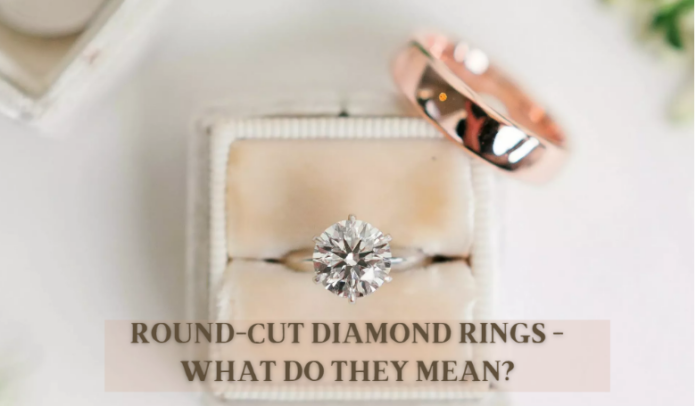For many years, diamonds have represented devotion and love. The round cut is the most well-liked and traditional of all the possible diamond shapes. Engagement rings, wedding bands, and other important occasions frequently feature round-cut diamond jewelry.
So, why is this circular cut so unique? What attributes make it the preferred option for couples everywhere? In this blog, we’ll discuss the significance of round-cut diamond rings, their appeal, and what you should know before purchasing one.
Understanding Diamond Cuts: What Does “Round Cut” Mean?
Diamonds are one of the most favorably prized gemstones in the world. They are known for their unique brilliance, appearance, and durability. Diamonds are formed over millions of years deep beneath the Earth’s surface, under intense heat and pressure. They are then mined and cut into various shapes to create beautiful jewelry as a gift to your loved one. In the modern day, diamonds are artificially created with advanced technologies and are environmentally friendly.
Round-cut diamonds are one of the most popular shapes for diamond jewelry. This cut features a circular shape with 58 facets, allowing maximum light reflection and brilliance. The circular shape of the diamond symbolizes eternity and unending love, making these round cut diamond engagement rings a meaningful choice for couples embarking on a lifetime of commitment.
In recent years, lab grown diamonds have also become increasingly popular. Lab grown diamonds are virtually identical to natural diamonds in terms of appearance, composition, and durability, but are generally less expensive than natural diamonds. These diamonds are created in a laboratory using advanced technology replicating the natural diamond-growing conditions.
Whether you choose a natural or lab-grown diamond, the round cut remains a timeless and classic choice for diamond jewelry.
The History of Round-Cut Diamond Rings
The round cut diamond ring has a long history that begins in the 1700s. Before that, diamonds were generally utilized in their uncut, unshaped natural state since they were so challenging to cut. The round cut was not possible until the middle of the 17th century when diamond-cutting technology had improved enough to enable such a shape.
In Europe, notably in France, where it was known as the “brilliant cut”, the round-cut diamond ring gained favor throughout the 18th century. The round amount was the most typical diamond form at this period and stayed so until the early 20th century.
More geometric diamond shapes, such as the emerald cut and the baguette cut, were popular in the 1910s and 1920s as a result of the art deco trend. Midway through the 20th century, the round cut, which had previously been the most popular diamond form, once again rose to prominence.
As it accounts for around 75% of all diamond sales, the round-cut diamond is now the most widely used diamond form worldwide. Couples shopping for an engagement ring or wedding band frequently like it because of its timeless and traditional style.
The Anatomy of a Round-Cut Diamond
The anatomy of a round-cut diamond refers to its different parts, which determine its beauty and value. Understanding these parts can help you choose the perfect round-cut diamond for your engagement ring or other jewelry.
Here is an easy-to-read guide to the anatomy of a round-cut diamond:
- Table: The flat top of the diamond is called the table.
- Crown: The crown is the upper part of the diamond, which includes the table and the crown facets.
- Girdle: The girdle is the line that surrounds the diamond’s widest point. The girdle dictates the width of the diamond.
- Pavilion: The pavilion refers to the bottom portion of the diamond that is beneath the girdle.
- Culet: The culet refers to the minuscule facet at the bottom of the diamond.
- Facets: These are the flat areas on the crown and pavilion of a diamond.
- Depth: The depth of the diamond is the distance from the table (top) to the culet (bottom) of the diamond.
- Diameter: The diameter of the diamond is measured across the span of its girdle.
A round cut diamond’s beauty, brightness, and value are greatly influenced by the measurements of these various components. Without proper adjustment of these proportions, the diamond may seem dull or unpleasant to the eye. A round-cut diamond’s cut grade should be taken into account to showcase general attractiveness and quality upon purchase.
Understanding the 4Cs of Round-Cut Diamond Rings
The carat weight, color, clarity, and cut are the factors that affect the quality of a round-cut diamond ring. The Gemological Institute of America (GIA) uses the 4Cs as a method for evaluating the quality of a diamond.
- Carat weight: The weight of the diamond is indicated by the term “carat weight” (1 carat = 0.2 grams). The carat weight is a good indicator of the diamond’s value. A 10-carat diamond will cost more than an 8-carat diamond with the same quality.
- Color: A diamond’s color can range from colorless to brown/yellow. A clear or colorless diamond is ideal. The Gemological Institute of America assigned different letters to indicate the color of the diamond (D for colorless and Z for brown/yellow). Opt for a color grade of G or higher to maximize the beauty of your round-cut diamond.
- Clarity: The presence of inclusions (internal flaws) and blemishes (external flaws) determines the clarity of a round-cut diamond. The clarity grade ranges from Flawless (no inclusions or blemishes visible under 10x magnification) to Included (inclusions visible to the naked eye). For round-cut diamonds, a clarity grade of VS2 or higher is recommended for optimal beauty.
- Cut: The most significant element influencing a diamond’s beauty is its cut. A diamond’s dimensions, symmetry, and polish are all included in a diamond’s cut. A diamond with good cutting will shine brightly and reflect light beautifully. A cut grade of Excellent or Very Good is advised for the best beauty in round-cut diamonds.
Understanding the 4Cs of diamond rings allows you to make an educated choice and make the most out of your investment. For the most value for your money, it’s crucial to take into account all four aspects when selecting a diamond.
Why Choose a Round-Cut Diamond Ring?
- Timeless and Classical Design: Among all the diamond shapes, the round cut has a timeless and classic design. It has been a favorite for many years and is still the most common diamond form in use today. A round-cut diamond ring will always be in fashion since it has a classic, never-out-of-style appearance.
- Maximum Sparkle and Brilliance: The round cut is made to optimize how much light enters the diamond and bounces back out, producing a breathtaking sparkle and brightness. Due to its 58 facets, which maximize light return, it produces an amazing show of light and fire.
- Eternity and love: A round-cut diamond is a symbolic option to express eternal love and commitment to your other half. The round/circular shape of the diamond makes it a symbol of unending love.
- Safe investment: Round-cut diamonds have a great resale value and are a safe investment. They are a popular choice, and their timeless beauty and high quality ensure they will retain their value over time.
It ultimately boils down to your choice and what you value in a diamond when picking a round-cut diamond ring. Nonetheless, the round cut is a top pick for many couples looking for the ideal engagement ring or wedding band due to its popularity, brightness, and meaning.
Pros and Cons of Round Cut Diamond Rings
For engagement rings and other jewelry, round-cut diamonds are among the most well-liked and traditional options. To be sure, there are advantages and disadvantages to picking a round-cut diamond ring, just as with any other diamond shape.
Pros
- Timeless beauty: The round-cut is a traditional diamond form that is always in fashion. It is a fantastic option for individuals looking for a timeless and elegant ring since it appeals to a wide audience.
- Maximum brilliance: The round cut is one of the most sparkling diamond shapes because it is made to highlight the diamond’s brightness and fire. Its 58 facets increase light’s brilliance by reflecting and refracting it in a variety of ways, giving it a beautiful and mesmerizing shine.
- Wider availability: Round-cut diamonds are widely available and often less expensive than other fancy shapes, making them more affordable. Their popularity makes them easier to find in a wide range of sizes, qualities, and price points.
- Forgiving cut: The round cut is forgiving and hides flaws and inclusions better than other diamond shapes. Its symmetry and proportion make it easier to hide inclusions and blemishes, which can make a lower clarity grade round cut diamond still appear beautiful and sparkly.
- Versatile setting options: Round-cut diamonds are versatile and can be set in a wide range of settings, from classic solitaire to vintage-inspired halo and pave settings. The round shape can complement any style or design, making it a flexible option for any taste or preference
Cons
- Less special: Round-cut diamonds are popular and traditional, but they are also less special. A round cut might not be the greatest option for you if you’re seeking a distinctive and uncommon diamond form.
- Prone to chipping: Round diamonds are more prone to chipping than other diamond shapes because of the way they are cut. They may be more prone to damage if struck against a hard surface since the corners and edges of a round diamond are more exposed.
Round Cut Diamond Ring Settings
A round-cut diamond ring’s setting is as essential to the diamond itself. It is crucial to pick a setting that enhances the round-cut diamond’s brightness and beauty since it may make or break the overall appearance of the ring.
Following are some popular round-cut diamond ring settings:
- Solitaire setting: The solitaire setting highlights the elegance of the round-cut diamond and is a traditional and timeless choice. A single round diamond is put in this understated setting on a plain band, highlighting the stone’s brilliance.
- Halo setting: In this ring setting, the round-cut diamond is the centerpiece and is surrounded by a halo of smaller diamonds. This results in an optical illusion that makes the round-cut diamond centerpiece look bigger and shinier than the other ring settings.
- Three-stone setting: Unlike the halo setting, the three-stone setting only has two smaller diamonds surrounding the centerpiece diamond. Many couples choose this ring setting because the three stones represent the past, present, and future of their relationships.
- Bezel: A bezel ring setting is a contemporary and stylish design that gives your round-cut diamond extra protection. The diamond is enclosed in a metal frame to give it a sleek and modern appearance.
Round Cut Diamond Ring Buying Guide
Diamonds are not cheap; they have always been a significant investment. Thus, you need proper knowledge and guidance in buying a diamond ring. Make an informed decision by following this buying guide for diamond rings.
- Determine your budget: The first thing to think about when buying a diamond ring is your budget. Make sure you can afford the diamond ring that you want. The price of a diamond ring will vary depending on the overall quality and size of the diamond.
- Choose the appropriate size: Before going to al jeweler, you have to determine the size of the diamond ring that you want. You don’t want to get a diamond ring that’s too narrow or too loose. Get the ring size of your partner without being too obvious to avoid ruining the surprise.
- Knowing the 4Cs: Having prior knowledge of the 4Cs of diamond quality gives you an advantage when choosing a diamond ring. It’s important to know these factors because they significantly affect the value of the diamond ring.
- Consider the ring’s setting: The ring’s setting has a significant impact on the appearance and overall worth of a round-cut diamond. Consider the setting style you choose, whether it is a classic solitaire setting, an elaborate halo, or a pavé setting.
- Choose a trustworthy jeweler: A round-cut diamond ring should only be purchased from a reputable jeweler that offers superior quality diamonds and exceptional customer services. One thing to check for when hiring a jeweler is AGS or GIA certifications from reputable grading laboratories.
- Inspect the diamond: Examine it carefully before purchasing to ensure it lives up to your expectations. Verify if there are any obvious flaws or imperfections and confirm that the diamond’s cut maximizes its shine.
- Consider financing options: If you’re on a tight budget, think about the financing alternatives the jeweler offers to help make your purchase more reasonable. You can opt for an investment plan if you are short on budget.
Caring for Your Round Cut Diamond Ring: Maintenance Tips
- Keep it clean: To maintain your ring with a round-cut diamond looking its best, regular cleaning is necessary. Cleaning the diamond and the metal band delicately requires the use of a soft-bristled brush and mild soap. Completely rinse with water, then pat dry with a soft towel.
- Store it properly: While not being worn, store your round-cut diamond ring in a spot that’s clean, dry, and safe. To prevent scratches, keep it apart from other jewelry while keeping it. To keep it safe from dust and moisture, think about using a jewelry box or a soft fabric pouch.
- Prevent chemical exposure: Bleach, chlorine, and other common home cleaners can harm both the metal and the diamond. Before using any chemicals or indulging in activities that might expose your ring to chemicals, take it off.
- Remove it during activities: While engaging in activities like gardening, sports, or domestic duties that might subject your round-cut diamond ring to impact or abrasion, it’s vital to take it off. By doing this, the metal band and diamond will be safeguarded from damage.
- Having it examined and cleaned by experts: It is advised to have your round-cut diamond ring cleaned and examined by a professional at least once a year to maintain its condition and spot any possible problems.
- Get insurance for your diamond ring: It’s important to have insurance for your round-cut diamond ring to protect your investment from loss or damage. To preserve your investment, think about purchasing a ring-specific insurance plan.
Conclusion: Is a Round Cut Diamond Ring Right for You?
Anybody wishing to make a statement with their jewelry will find a round-cut diamond ring to be a timeless and traditional option. It is simple to understand why the round cut is one of the most popular diamond cuts today given its stunning shine, adaptability, and symbolic significance.
The decision to choose a round-cut diamond ring, however, should be based on your taste, style, and financial capacity. While choosing the ideal diamond for your ring, it’s crucial to keep things like the cut, clarity, color, carat weight, and certification in mind.
A round-cut diamond ring is guaranteed to become a prized item of jewelry that will be passed down for many generations, whether you pick it as an engagement or wedding band or just as a statement piece.
In conclusion, if you appreciate a timeless, adaptable appearance, a round-cut diamond ring can be the best option for you. Round-cut diamond rings continue to be a popular option for diamond jewelry fans all around the world because of their unrivaled glitter and symbolic significance.

















